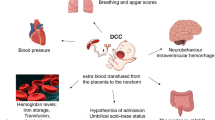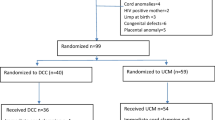Abstract
Aim of the study
To evaluate if gestational age (GA), mode of delivery and abdominal wall closure method influence outcomes in uncomplicated gastroschisis (GTC).
Methods
Retrospective review of NICU admissions for gastroschisis, August 2008–July 2016. Primary outcomes were: time to start enteral feeds (on-EF), time to discontinue parenteral nutrition (off-PN), and length of stay (LOS).
Main results
A total of 200 patients with GTC were admitted to our NICU. Patients initially operated elsewhere (n = 13) were excluded. Patients with medical/surgical complications (n = 62) were analyzed separately. The study included 125 cases of uncomplicated GTC. There were no statistically significant differences in the outcomes of patients born late preterm (34 0/7–36 6/7; n = 70) and term (n = 40): on-EF 19 (5–54) versus 17 (7–34) days (p = 0.29), off-PN 32 (12–101) versus 30 (16–52) days (p = 0.46) and LOS 40 (18–137) versus 37 (21–67) days (p = 0.29), respectively. Patients born before 34 weeks GA (n = 15) had significantly longer on-EF, off-PN and LOS times compared to late preterm patients: 26 (12–50) days (p = 0.01), 41 (20–105) days (p = 0.04) and 62 (34–150) days (p < 0.01), respectively. There were no significant differences in outcomes between patients delivered by C-section (n = 62) and patients delivered vaginally (n = 63): on-EF 20 (5–50) versus 19 (7–54) days (p = 0.72), off-PN 32 (12–78) versus 33 (15–105) days (p = 0.83), LOS 42 (18–150) versus 41 (18–139) days (p = 0.68), respectively. There were significant differences in outcomes between patients who underwent primary reduction (n = 37) and patients who had a silo (88): on-EF 15 (5–37) versus 22 (6–54) days (p < 0.01), off-PN 28 (12–52) versus 34 (15–105) days (p = 0.04), LOS 36 (18–72) versus 44 (21–150) days (p = 0.04), respectively.
Conclusion
In our experience, late preterm delivery did not affect outcomes compared to term delivery in uncomplicated GTC. Outcomes were also not influenced by the mode of delivery. Patients who underwent primary reduction had better outcomes than patients who underwent silo placement.
Similar content being viewed by others
References
Grossman M, Fischermann EA, German J (1978) Sonographic findings in gastroschisis. J Clin Ultrasound 6:175–176
Stringel G, Filler RM (1979) Prognostic factors in omphalocele and gastroschisis. J Pediatr Surg 14:515–519
Lewis JE Jr, Kraeger RR, Danis RK (1973) Gastroschisis: ten-year review. Arch Surg 107:218–222
Young DG. Gastroschisis (1967) Proc R Soc Med 60:15–16
Dalton BG, Gonzalez KW, Reddy SR et al (2016) Improved outcomes for inborn babies with uncomplicated gastroschisis. J Pediatr Surg. https://doi.org/10.1016/j.jpedsurg.2016.12
Youssef F, Cheong LH, Emil S (2016) Gastroschisis outcomes in North America: a comparison of Canada and the United States. J Pediatr Surg 51:891–895
Marshall Niles SG, Mitchell-Fearon K, Gill MI et al (2017) Mortality-related factors in gastroschisis—a Jamaican perspective. J Pediatr Surg 52:530–533
Wesonga AS, Fitzgerald TN, Kabuye R et al (2016) Gastroschisis in Uganda: opportunities for improved survival. J Pediatr Surg 51:1772–1777
Apfeld JC, Wren SM, Macheka N et al (2015) Infant, maternal, and geographic factors influencing gastroschisis related mortality in Zimbabwe. Surgery 158:1475–1480
Badillo AT, Hedrick HL, Wilson RD et al (2008) Prenatal ultrasonographic gastrointestinal abnormalities in fetuses with gastroschisis do not correlate with postnatal outcomes. J Pediatr Surg 43:647–653
Alfaraj MA, Ryan G, Langer JC et al (2011) Does gastric dilation predict adverse perinatal or surgical outcome in fetuses with gastroschisis? Ultrasound Obstet Gynecol 37:202–206
Page R, Ferraro ZM, Moretti F et al (2014) Gastroschisis: antenatal sonographic predictors of adverse neonatal outcome. J Pregnancy 2014:239406. https://doi.org/10.1155/2014/239406
Davis RP, Treadwell MC, Drongowski RA et al (2009) Risk stratification in gastroschisis: can prenatal evaluation or early postnatal factors predict outcome? Pediatr Surg Int 25:319–325
Langer JC, Longaker MT, Crombleholme TM et al (1989) Etiology of intestinal damage in gastroschisis. I: effects of amniotic fluid exposure and bowel constriction in a fetal lamb model. J Pediatr Surg 24:992–997
Api A, Olguner M, Hakgüder G et al (2001) Intestinal damage in gastroschisis correlates with the concentration of intraamniotic meconium. J Pediatr Surg 36:1811–1815
Correia-Pinto J, Tavares ML, Baptista MJ et al (2002) Meconium dependence of bowel damage in gastroschisis. J Pediatr Surg 37:31–35
Moir CR, Ramsey PS, Ogburn PL et al (2004) A prospective trial of elective preterm delivery for fetal gastroschisis. Am J Perinatol 21:289–294
Serra A, Fitze G, Kamin G et al (2008) Preliminary report on elective preterm delivery at 34 weeks and primary abdominal closure for the management of gastroschisis. Eur J Pediatr Surg 18:32–37
Peiró JL, Guindos S, Lloret J et al (2005) New surgical strategy in gastroschisis: treatment simplification according to its physiopathology. Cir Pediatr 18:182–187
Schib K, Schumacher M, Meuli M et al (2017) Prenatal and postnatal management of gastroschisis in German-speaking countries: is there a standardized management? Eur J Pediatr Surg. https://doi.org/10.1055/s-0037-1598103
Mesas Burgos C, Svenningsson A, Vejde JH (2015) Outcomes in infants with prenatally diagnosed gastroschisis and planned preterm delivery. Pediatr Surg Int 31:1047–1053
Krause H, Hass HJ, Böttger R et al (2015) Surgical treatment results in gastroschisis based on preterm delivery within the 34th week of gestation by caesarean section. Pol Przegl Chir 87:346–356
Fernández Ibieta M, Aranda García MJ, Cabrejos Perotti C et al (2013) Preliminary results of a multidisciplinary approach to gastroschisis. Cir Pediatr 26:30–36
Carnaghan H, Baud D, Lapidus-Krol E et al (2016) Effect of gestational age at birth on neonatal outcomes in gastroschisis. J Pediatr Surg 51:734–738
Carnaghan H, Pereira S, James CP et al (2014) Is early delivery beneficial in gastroschisis? J Pediatr Surg 49:928–933
Bond DM, Gordon A, Hyett J et al (2015) Planned early delivery versus expectant management of the term suspected compromised baby for improving outcomes. Cochrane Database Syst Rev (11):CD009433. https://doi.org/10.1002/14651858.CD009433
Wilson MS, Carroll MA, Braun SA et al (2012) Is preterm delivery indicated in fetuses with gastroschisis and antenatally detected bowel dilation? Fetal Diagn Ther 32:262–266
Bethel CA, Seashore JH, Touloukian RJ (1989) Cesarean section does not improve outcome in gastroschisis. J Pediatr Surg 24:1–3
Lenke RR, Hatch EI Jr (1986) Fetal gastroschisis: a preliminary report advocating the use of cesarean section. Obstet Gynecol 67:395–398
Grundy H, Anderson RL, Filly RA et al (1987) Gastroschisis: prenatal diagnosis and management. Fetal Ther 2:144–147
Langer JC, Harrison MR, Adzick NS et al (1987) Perinatal management of the fetus with an abdominal wall defect. Fetal Ther 2:216–221
Reigstad I, Reigstad H, Kiserud T et al (2011) Preterm elective caesarean section and early enteral feeding in gastroschisis. Acta Paediatr 100:71–74
Dalton BG, Gonzalez KW, Reddy SR et al (2016) Improved outcomes for inborn babies with uncomplicated gastroschisis. J Pediatr Surg 52(7):1132–1134
Sacks GD, Ulloa JG, Shew SB (2016) Is there a relationship between hospital volume and patient outcomes in gastroschisis repair? J Pediatr Surg 51:1650–1654
Savoie KB, Huang EY, Aziz SK et al (2014) Improving gastroschisis outcomes: does birth place matter? J Pediatr Surg 49:1771–1775
Luck SR, Sherman JO, Raffensperger JG et al (1985) Gastroschisis in 106 consecutive newborn infants. Surgery 98:677–683
Banyard D, Ramones T, Phillips SE et al (2010) Method to our madness: an 18-year retrospective analysis on gastroschisis closure. J Pediatr Surg 45:579–584
Dore Reyes M, Triana Junco P, Barrena Delfa S et al (2016) Primary versus secondary closure: ventilatory and nutritional differences in patients with gastrosquisis. Cir Pediatr 29:49–53
Bianchi A, Dickson AP (1998) Elective delayed reduction and no anesthesia: ‘minimal intervention management’ for gastrochisis. J Pediatr Surg 33:1338–1340
Pet GE, Stark RA, Meehan JJ et al (2017) Outcomes of bedside sutureless umbilical closure without endotracheal intubation for gastroschisis repair in surgical infants. Am J Surg 213(5):958–962
Zhang ZT, Liu CX, Zhou YZ et al (2010) Intrapartum operation on fetuses with birth defects and its outcome. Zhonghua Fu Chan Ke Za Zhi 45:652–657
Author information
Authors and Affiliations
Corresponding author
Rights and permissions
About this article
Cite this article
Fraga, M.V., Laje, P., Peranteau, W.H. et al. The influence of gestational age, mode of delivery and abdominal wall closure method on the surgical outcome of neonates with uncomplicated gastroschisis. Pediatr Surg Int 34, 415–419 (2018). https://doi.org/10.1007/s00383-018-4233-5
Accepted:
Published:
Issue Date:
DOI: https://doi.org/10.1007/s00383-018-4233-5




